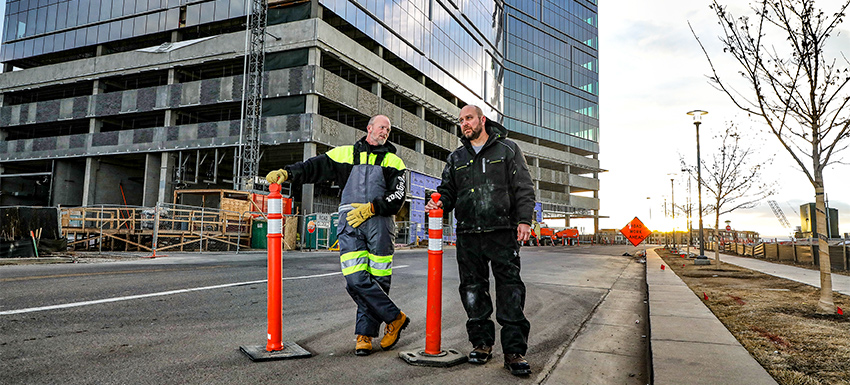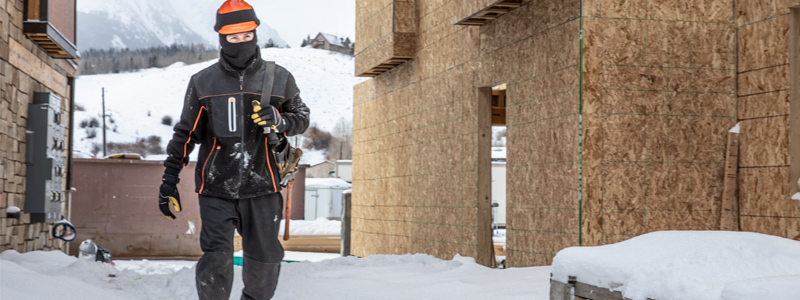- Recent Articles
-
Product Guides
-
Garments
- TOP 5 THINGS TO LOOK FOR IN THE WARMEST JACKETS
- WHY DO YOU NEED COLD WEATHER BIB OVERALLS?
- 5 ALL WEATHER JACKETS YOU CAN WEAR IN ANY SEASON
- 5 WORK SWEATSHIRTS AND HOODIES THAT ARE PERFECT FOR FALL TEMPERATURES
- 7 OF THE BEST WORK JACKETS FOR MEN
- 8 BEST HIGH-VISIBILITY JACKETS FOR CONSTRUCTION WORKERS
- COVERALLS vs. BIBS: WHICH ONE IS RIGHT FOR YOU?
- HOW AND WHY TO CHOOSE A PUFFER JACKET
- HOW TO CHOOSE THE BEST INSULATED BIB OVERALLS
- HOW TO CHOOSE THE RIGHT FLEECE JACKET
- BEST INSULATED GEAR FOR WOMEN
- OUTWORK ANY WEATHER WITH PREMIUM JACKETS
- THE BEST PANTS FOR COLD WEATHER
- TOP 7 FEATURES OF A SUBZERO SWEATSHIRT
- WHAT ARE THE BEST SWEATSHIRTS TO WEAR FOR COLD WEATHER?
- WHAT IS THE DIFFERENCE BETWEEN A DOWN JACKET AND A PUFFER JACKET?
- WHY AND WHEN TO WEAR A VEST FOR WARMTH
- TOP 4 OPTIONS FOR SPRING AND FALL GEAR
- 3 THINGS YOU NEED TO KNOW ABOUT HIVIS WORKWEAR
- TOP 5 MUST-HAVE FEATURES FOR RAINWEAR
- WHY DO YOU NEED A FREEZER SUIT IN THE GROCERY BUSINESS?
- WHY YOU SHOULD LOOK FOR BREATHABILITY AND WICKABILITY IN COLD WEATHER WORKWEAR
-
Footwear
- 6 MOST DURABLE COLD WEATHER WORK BOOTS FOR MEN
- CASE STUDY: KEEPING CREWS ON THEIR FEET WITH PROPER FOOTWEAR
- HOW TO CHOOSE THE RIGHT SIZE WORKBOOT
- HOW TO EXTEND THE LIFE OF YOUR WORK BOOTS
- HOW TO FIND THE PERFECT WORK BOOTS FOR LANDSCAPING
- THE SCIENCE BEHIND MOISTURE-WICKING SOCKS
- YOUR FEET WILL THANK YOU FOR WEARING THESE WORK BOOTS
- 5 TIPS FOR CHOOSING THE BEST WORK BOOT
- Headwear
-
Gloves
- TOP 5 WATERPROOF WORK GLOVES
- 5 UTILITY GLOVES THAT KEEP YOU WARM IN EXTREME COLD
- GIVE COLD THE FINGER: TOP 5 FEATURES OF PREMIUM GLOVES
- HOW TO USE GLOVE LINERS
- TOP 3 ADVANTAGES OF PERFORMANCE GLOVES
- 3 WAYS TOUCHSCREEN GLOVES MAKE YOUR JOB EASIER
- TOP 4 THINGS TO LOOK FOR IN WATERPROOF GLOVES
- HOW TO WEAR GLOVE LINERS ON THE JOB
- 9 WORK GLOVES BUILT FOR SERIOUS PROTECTION AND PERFORMANCE
- 9 MUST-HAVE FEATURES FOR WAREHOUSE WORK GLOVES
- Use & Care
-
Garments
-
RefrigiWear Knowledge
- 10 ESSENTIAL PIECES OF COLD WEATHER GEAR FOR FARMERS
- 10 TIPS FOR WORKING SAFELY IN COLD WEATHER
- 3 REASONS WHY FREEZER SUITS ARE ESSENTIAL FOR WORKING IN THE COLD
- A BEGINNER’S GUIDE TO WORKING OUTSIDE
- ADVANTAGES OF SYNTHETIC INSULATION
- COLD WEATHER GEAR FOR OUTDOOR ACTIVITIES
- HOW TO AVOID DRAFTS IN COLD WEATHER WORK CLOTHES
- HOW TO STAY WARM FROM HEAD TO TOE IN COLD WEATHER
- HOW TO STAY WARM ON THE JOB SITE
- HOW TO STORE WINTER WORKWEAR FOR THE SUMMER
- HOW TO USE REFRIGIWEAR COMFORT RATINGS TO CHOOSE INSULATED GEAR
- THE HEALTH RISKS OF WEARING TOO MUCH COLD WEATHER GEAR
- THE IMPORTANCE OF PROPER FOOT CARE WHEN WORKING IN THE COLD
- THE ULTIMATE SAFETY CHECKLIST FOR CONSTRUCTION WORKERS IN COLD CONDITIONS
- WHAT SHOULD I WEAR FOR SNOWMOBILING?
- WHAT’S THE TOUGHEST GEAR FOR COLD WEATHER?
- WHICH TYPE OF SLEEVE IS RIGHT FOR YOUR WINTER ACTIVITY?
- TOP 5 COLDEST AMERICAN CITIES AND HOW TO STAY WARM
- TOP 4 TIPS FOR WORKING IN THE RAIN
- 5 TIPS FOR MOTORCYCLING IN WINTER
- HOW TO DRESS FOR THE COLD IN 4 EASY STEPS
- A BEGINNER’S GUIDE TO STAYING WARM WHILE WORKING IN THE COLD
- HOW TO STAY WARM WHEN WORKING IN THE COLD
- Stories

THE ULTIMATE SAFETY CHECKLIST FOR CONSTRUCTION WORKERS IN COLD CONDITIONS
Some days, Mother Nature does her damnedest to keep you inside, but you know the job still has to get done. When you work construction in the cold, you need right knowledge and the right gear to keep yourself safe and working hard—so let’s talk about some safety practices for extreme cold conditions.
Know Your Enemy
The cold has many weapons in its arsenal, the biggest being frostbite, frostnip, trench foot and hypothermia. It’s important to have response procedures ready to roll if there’s a cold-related health emergency.
Some conditions, like frostbite, usually need medical attention from a professional. Others, like frostnip, can probably be treated on-site if you have a warm place to go. So read up on first aid for cold-related injuries, stock first aid and winter survival kits in all of your company vehicles and have an in-depth plan for how to transport an injured person to the nearest doctor or hospital.
Prepping the Job Site
A construction site should have special preparations in cold weather. Before work starts, use rock salt or de-icer to melt ice on walkways and clear snow from the ground and rooftops. Make sure there are walkable paths, laying some gravel down if you need to.
Any cold-weather job site needs a designated place where workers can easily get warm. Whether you’re applying first aid or just taking a coffee break, it’s important that nobody has to be out in the cold unless they’re working. Every employee on the job site should be taking frequent breaks to warm up—some experts even recommend breaks as often as every 20 to 30 minutes if it’s really cold.
Tents and trailers are popular forms of pop-up shelters for warmth. Even vehicles can do the trick in a pinch, though you don’t want to rely on them too much. A big part of staying warm is staying dry, so make sure your chosen shelter seals out rain and snow.

Multiple Layers of Cold-Weather Clothing
Most construction projects start with laying a foundation and building up from there. That’s how your cold-weather gear should work, too.
Build your armor against the cold by putting on multiple layers of protection, including a moisture-wicking base layer, and insulated mid-layer such as a hoodie and a weatherproof outer layer such as a jacket or coveralls.
Footwear that Kicks Serious Ice
From frostbite to trench foot, it’s clear that the cold is dangerous to a worker’s feet. You need boots with these key features to make sure you get the right pair of cold-weather work boots:
Insulation
Use RefrigiWear® Comfort Ratings to help find the right amount of insulation for the temperatures you face.
Soles
Anti-slip rubber outsoles help you stand strong amid ice and mud. Puncture-resistant rubber plates to help you avoid dangers like exposed nails.
Waterproofing
Water inside your boots can lead to trench foot and it can wreck your body’s internal temperatures. You can trust the high-grade waterproofing on RefrigiWear® insulated work boots to keep your feet dry even in the wettest conditions.
Performance Socks
Even the best boots can’t reach their potential if they don’t have performance socks working with them, so remember to pick up a pair of moisture-wicking, comfort-soft work socks.
Gloves that Can Handle It
Well-insulated gloves are a must and RefrigiWear has options like the ultra-thick Iron-Tuff® Insulated Leather Gloves or lighter like our Insulated Wool Gloves. It’s also important you have enough dexterity to work without taking your gloves off, so consider the warm and flexible waterproof Frostline Glove.
If you have to operate a touch screen or a keypad, check out our gloves with exclusive Key-Rite and Touch-Rite screw-on nibs that attach to glove fingers and make device operation a cinch.
High-Quality Headwear
Your jobs takes brains. It’s important to keep yours safe. Proper headwear is another must-have for a cold-weather job site.
A classic beanie, like the RefrigiWear® ChillBreaker™ Cap, can go a long way toward keeping your head warm and dry. If you’re worried about extreme wind levels, a full-face balaclava might give you better protection. And, if precipitation is on your mind, think about options like our Iron-Tuff® Snap-On Hoods.
Take Precautions to Outwork Mother Nature
Mother Nature will try to take you down. If you’re gonna outwork her, make sure your jobsite is fully prepared. Follow our tips to work safely in cold weather, like drinking plenty of water to avoid dehydration, packing an extra change of base layer clothes in case you get wet and, since the cold puts stress on your immune system, sanitizing hands often to avoid getting sick.
No matter what the thermometer says, the job’s still gotta get done. If you follow these steps and equip yourself with the right gear, nothing will slow you down. Now get out there and show the cold who’s boss.